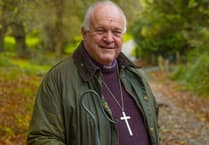It is a truism of history that villains and disasters get remembered, while the good and positive get forgotten, writes Judith Field.
But the Victorians who planned the history windows at Truro Cathedral thought differently - they selected characters whose faith had motivated them to reach higher, and do more.
Erasmus of Rotterdam (1466 to 1536) may no longer be a household name, but it’s no exaggeration to say his legacy affects how we think and live today. One of the most famous men in Europe in the early 1500s, there are several university institutions named after him worldwide, as well as a European programme enabling students and teachers to study and work abroad.
The illegitimate son of a Catholic priest, Erasmus came from a difficult background which stopped him taking up a university place as a teenager. Instead, he did it the hard way: working his way up as a monk (which he hated), then priest, then administrator and finally eminent academic at the best universities of his day – Louvain, Oxford, Cambridge and Turin.
Top scholars like Erasmus travelled the continent, and their ideas paved the way for a new, rational way of thinking that eventually underpinned the science and discoveries we take for granted.
Erasmus was an unconventional thinker, and didn’t just take at face value what he was told. He believed in checking the facts and testing the evidence. God, he argued, had given humanity minds for a reason - so that we could think!
He taught himself Greek so he could translate the Bible’s New Testament from the original manuscripts, and in doing so discovered mistakes in the version that had been used by the church for 1,000 years.
Rituals, shrines and relics seemed ridiculous to him, and he regularly lampooned them in his books.
Known as the father of Humanism, Erasmus campaigned for politics and religion to be based on rational debate and respect for alternative views. But the rapid spread of what was then the new technology of printing (rather like social media today) produced an explosion of unverified “facts” that undermined social stability and produced an atmosphere of populism, intolerance and violence.
Consulted by both the Pope and radical Protestant Martin Luther, Erasmus justly feared religious conflict. He wanted the Catholic church to reform from within rather than split apart.
Truro’s window groups two other Humanists with Erasmus: the pioneering teacher John Colet and the politician Sir Thomas More. What makes this highly unusual is that all three men were personal friends and all of the likenesses are based on portraits by the famous Tudor artist, Hans Holbein (from originals now in London and New York).
More was beheaded by Henry VIII in 1535 for his religious beliefs, and Erasmus himself had to flee Switzerland in 1529. He became a religious refugee in Freiburg, Germany, but it’s nice to think he might have been just as much at home in Truro – with three-spired cathedrals and water flowing through cobbled streets, the cities have a lot in common!
Find out more at www.cornishstainedglass.org.uk
-and-his-friend-Sir-Thomas-More-in-Truro-Cathedral-Photo-by-Mark-Charter.png?trim=0,0,0,0&width=752&height=502&crop=752:502)




Comments
This article has no comments yet. Be the first to leave a comment.